The NVIDIA GeForce GTX 1080 & GTX 1070 Founders Editions Review: Kicking Off the FinFET Generation
by Ryan Smith on July 20, 2016 8:45 AM ESTOverclocking
For our final evaluation of the GTX 1080 and GTX 1070 Founders Edition cards, let’s take a look a overclocking.
Whenever I review an NVIDIA reference card, I feel it’s important to point out that while NVIDIA supports overclocking – why else would they include fine-grained controls like GPU Boost 3.0 – they have taken a hard stance against true overvolting. Overvolting is limited to NVIDIA’s built in overvoltage function, which isn’t so much a voltage control as it is the ability to unlock 1-2 more boost bins and their associated voltages. Meanwhile TDP controls are limited to whatever value NVIDIA believes is safe for that model card, which can vary depending on its GPU and its power delivery design.
For GTX 1080FE and its 5+1 power design, we have a 120% TDP limit, which translates to an absolute maximum TDP of 216W. As for GTX 1070FE and its 4+1 design, this is reduced to a 112% TDP limit, or 168W. Both cards can be “overvolted” to 1.093v, which represents 1 boost bin. As such the maximum clockspeed with NVIDIA’s stock programming is 1911MHz.
| GeForce GTX 1080FE Overclocking | ||||
| Stock | Overclocked | |||
| Core Clock | 1607MHz | 1807MHz | ||
| Boost Clock | 1734MHz | 1934MHz | ||
| Max Boost Clock | 1898MHz | 2088MHz | ||
| Memory Clock | 10Gbps | 11Gbps | ||
| Max Voltage | 1.062v | 1.093v | ||
| GeForce GTX 1070FE Overclocking | ||||
| Stock | Overclocked | |||
| Core Clock | 1506MHz | 1681MHz | ||
| Boost Clock | 1683MHz | 1858MHz | ||
| Max Boost Clock | 1898MHz | 2062MHz | ||
| Memory Clock | 8Gbps | 8.8Gbps | ||
| Max Voltage | 1.062v | 1.093v | ||
Both cards ended up overclocking by similar amounts. We were able to take the GTX 1080FE another 200MHz (+12% boost) on the GPU, and another 1Gbps (+10%) on the memory clock. The GTX 1070 could be pushed another 175MHz (+10% boost) on the GPU, while memory could go another 800Mbps (+10%) to 8.8Gbps.
Both of these are respectable overclocks, but compared to Maxwell 2 where our reference cards could do 20-25%, these aren’t nearly as extreme. Given NVIDIA’s comments on the 16nm FinFET voltage/frequency curve being steeper than 28nm, this could be first-hand evidence of that. It also indicates that NVIDIA has pushed GP104 closer to its limit, though that could easily be a consequence of the curve.
Given that this is our first look at Pascal, before diving into overall performance, let’s first take a look at an overclocking breakdown. NVIDIA offers 4 knobs to adjust when overclocking: overvolting (unlocking additional boost bins), increasing the power/temperature limits, the memory clock, and the GPU clock. Though all 4 will be adjusted for a final overclock, it’s often helpful to see whether it’s GPU overclocking or memory overclocking that delivers the greater impact, especially as it can highlight where the performance bottlenecks are on a card.
To examine this, we’ve gone ahead and benchmarked the GTX 1080 4 times: once with overvolting and increased power/temp limits (to serve as a baseline), once with the memory overclocked added, once with GPU overclock added, and finally with both the GPU and memory overclocks added.
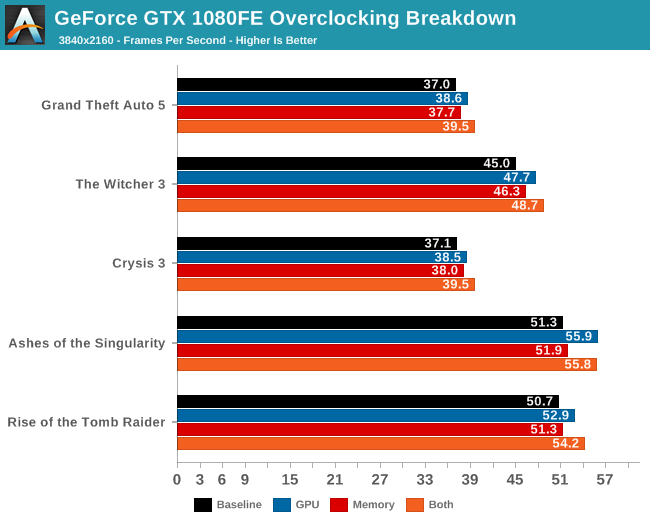
| GeForce GTX 1080 Overclocking Performance | ||||||
| Power/Temp Limit (+20%) | Core (+12%) | Memory (+10%) | Cumulative | |||
| Tomb Raider |
+3%
|
+4%
|
+1%
|
+10%
|
||
| Ashes |
+1%
|
+9%
|
+1%
|
+10%
|
||
| Crysis 3 |
+4%
|
+4%
|
+2%
|
+11%
|
||
| The Witcher 3 |
+2%
|
+6%
|
+3%
|
+10%
|
||
| Grand Theft Auto V |
+1%
|
+4%
|
+2%
|
+8%
|
||
Across all 5 games, the results are clear and consistent: GPU overclocking contributes more to performance than memory overclocking. To be sure, both contribute, but even after compensating for the fact that the GPU overclock was a bit greater than the memory overclock (12% vs 10%), we still end up with the GPU more clearly contributing. Though I am a bit surprised that increasing the power/temperature limit didn't have more of an effect.
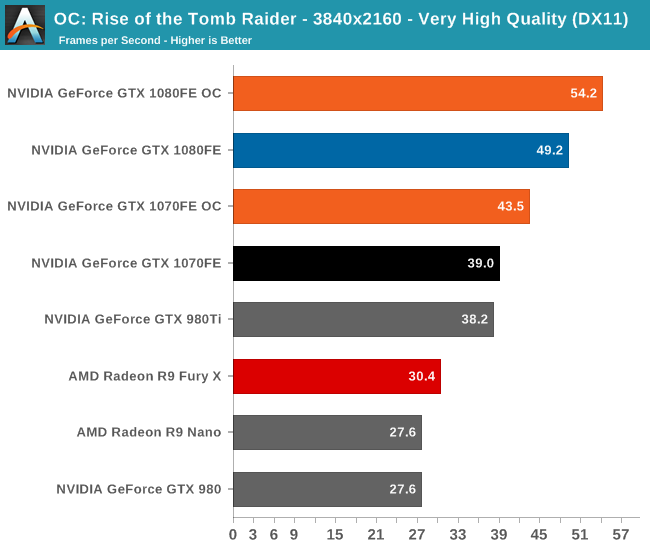
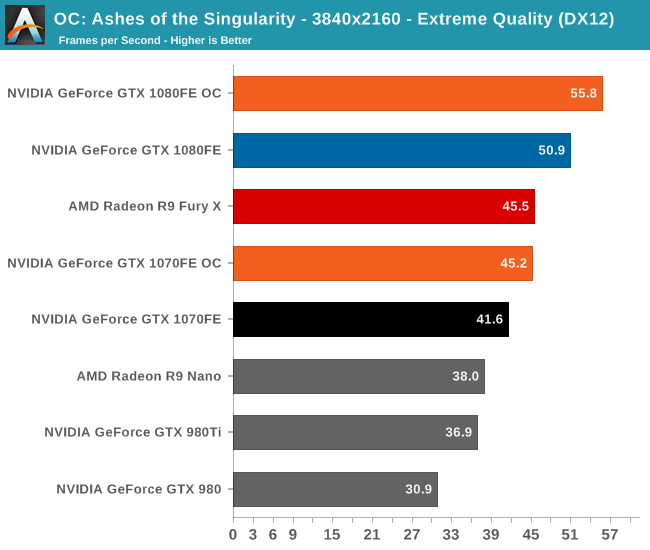

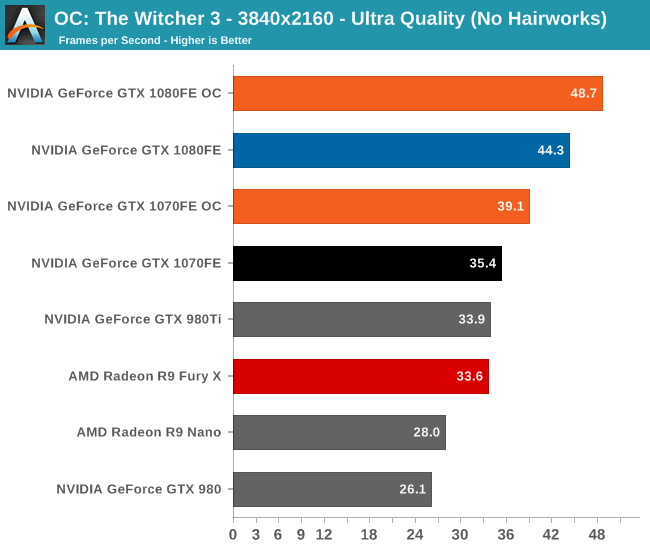
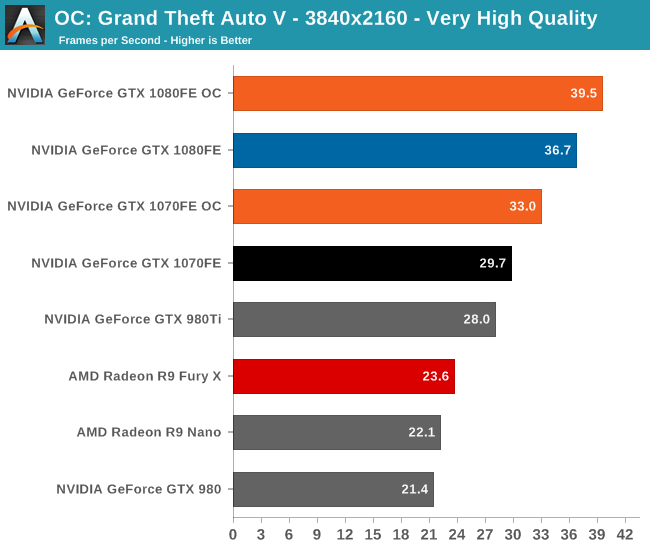
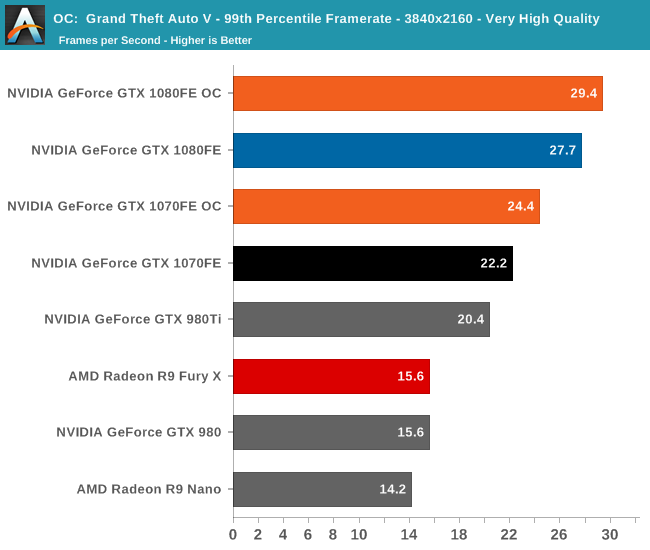
Overall we’re looking at an 8%-10% increase in performance from overclocking. It’s enough to further stretch the GTX 1080FE and GTX 1070FE’s leads, but it won’t radically alter performance.
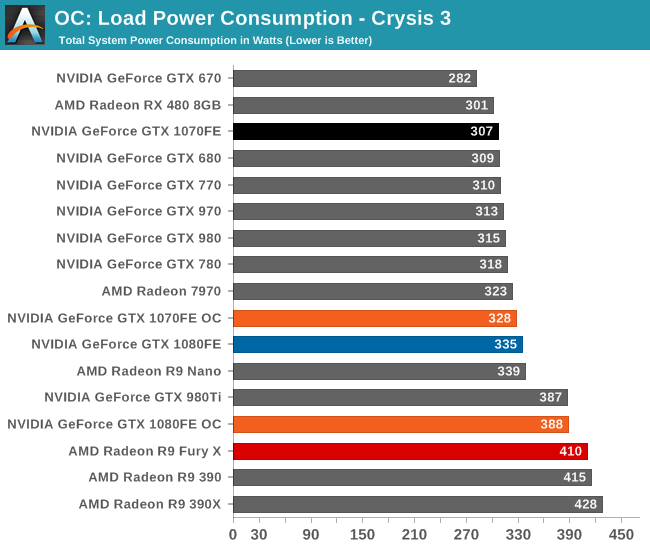
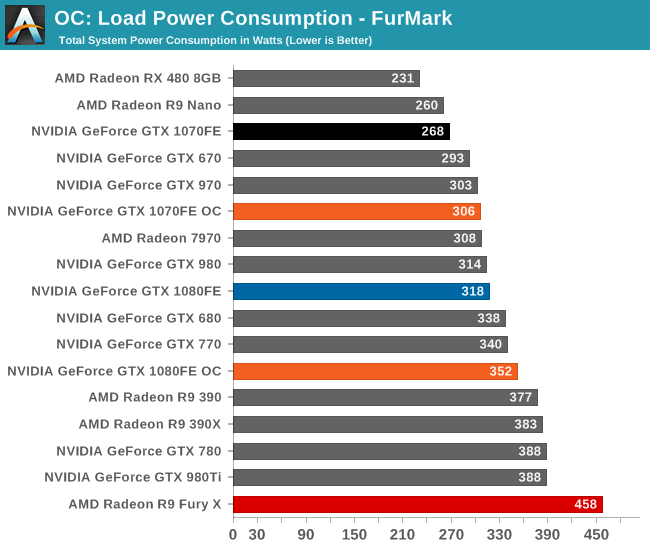
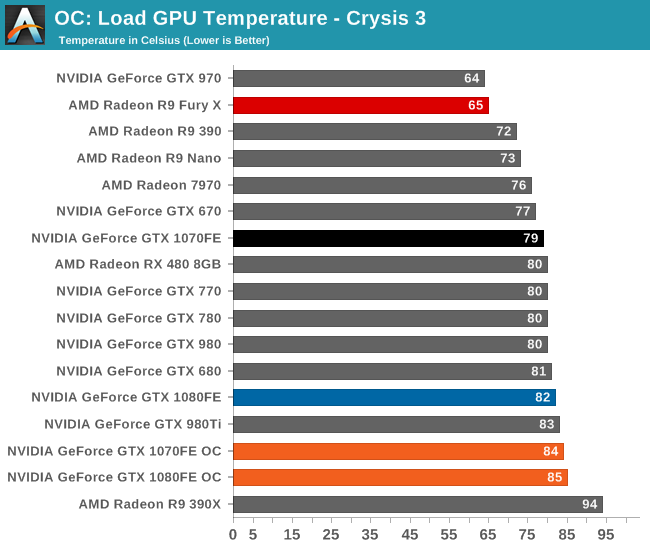

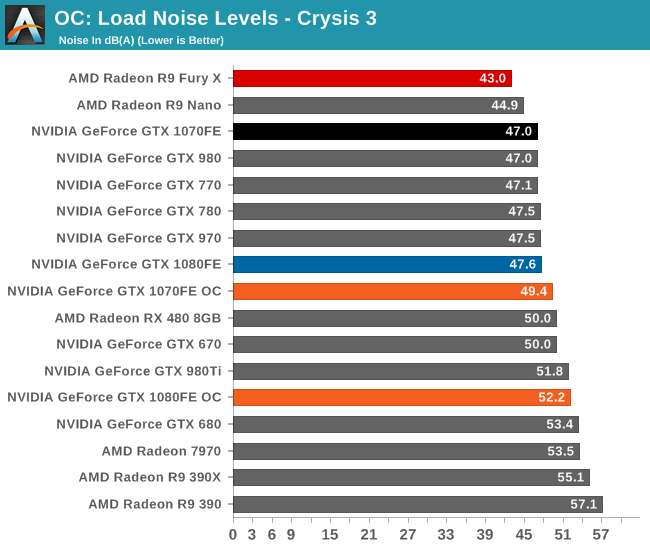
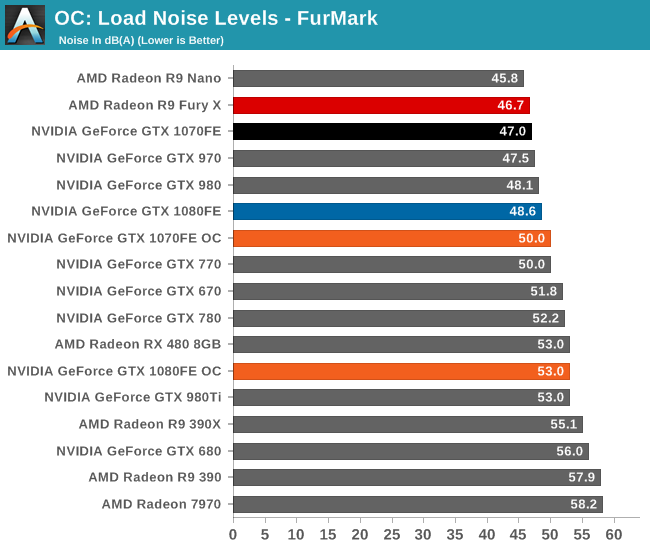
Finally, let’s see the cost of overclocking in terms of power, temperature, and noise. For the GTX 1080FE, the power cost at the wall proves to be rather significant. An 11% Crysis 3 performance increase translates into a 60W increase in power consumption at the wall, essentially moving GTX 1080FE into the neighborhood of NVIDIA’s 250W cards like the GTX 980 Ti. The noise cost is also not insignificant, as GTX 1080FE has to ramp up to 52.2dB(A), a 4.6dB(A) increase in noise. Meanwhile FurMark essentially confirms these findings, with a smaller power increase but a similar increase in noise.
As for the GTX 1070FE, neither the increase in power consumption nor noise is quite as high as GTX 1080FE, though the performance uplift is also a bit smaller. The power penalty is just 21W at the wall for Crysis 3 and 38W for FurMark. This translates to a 2-3dB(A) increase in noise, topping out at 50.0dB for FurMark.










200 Comments
View All Comments
bill44 - Friday, July 22, 2016 - link
That's the problem. I know nothing about the 900 series audio capabilities (which I suppose is the same as the 800 series ;) ) and no one publishes them in review. All reviews are incomplete.Anyone here knows at least the supported audio sampling rates? If not, I think my best bet is going with AMD (which I'm shure supports 88.2 & 176.4 KHz).
bill44 - Saturday, July 23, 2016 - link
Anyone?poohbear - Wednesday, July 20, 2016 - link
thank you for the review, late as it is it's still an excellent review and love the details!junky77 - Wednesday, July 20, 2016 - link
In other reviews, even a Haswell-E is limited for GPUs like GTX 1070JamesAnthony - Wednesday, July 20, 2016 - link
I really appreciate all the work that went into this in depth review.I especially am very glad that you included the GTX 680 in the benchmarks along with all the other cards after it.
It's often really hard to get an overview of performance over a couple years.
I'm looking at upgrading 2 systems from GTX680 to either GTX 1070 or GTX 1060 and Titan (original one) to GTX 1080, so this helps see what the performance would be like.
Hopefully you tested the 1060 the same way so I can just plug the numbers for it into the same graph.
Thanks again!
Ryan Smith - Wednesday, July 20, 2016 - link
Be sure to check Bench. The 1060 results are already there, so you can see those comparisons right now.fivefeet8 - Wednesday, July 20, 2016 - link
2nd page 3rd paragraph: "generational increate in performance". ;increase?2nd page 2nd section: "Pascal in an architecture that I’m not sure has any real parallel on a historical basis". ;is?
hansmuff - Wednesday, July 20, 2016 - link
Great review, i like that you went into all the hardware details. Worth the wait.Chaser - Wednesday, July 20, 2016 - link
I'm a Nvidia guy all the way. For now. I am disappointed in the midrange RX480 and it's power consumption compared to the competition, especially after they had said that Polaris was goingto primarily be an efficiency improvement.Outside of my bias I truly hope AMD provides a very competitive flagship in the near future. Everyone wins. But with the 1060 now announced it just makes AMD's GPU prospects and profitability questionable.
MarkieGcolor - Wednesday, July 20, 2016 - link
So basically after all the hype about finfet, we get a standard, if not disappointing jump this generation also with a price hike. I'm so relieved that I didn't wait for this generation and can just enjoy my current 970 sli/nano crossfire rigs. AMD easily has the opportunity to blow these cards out of the water with big gpus.